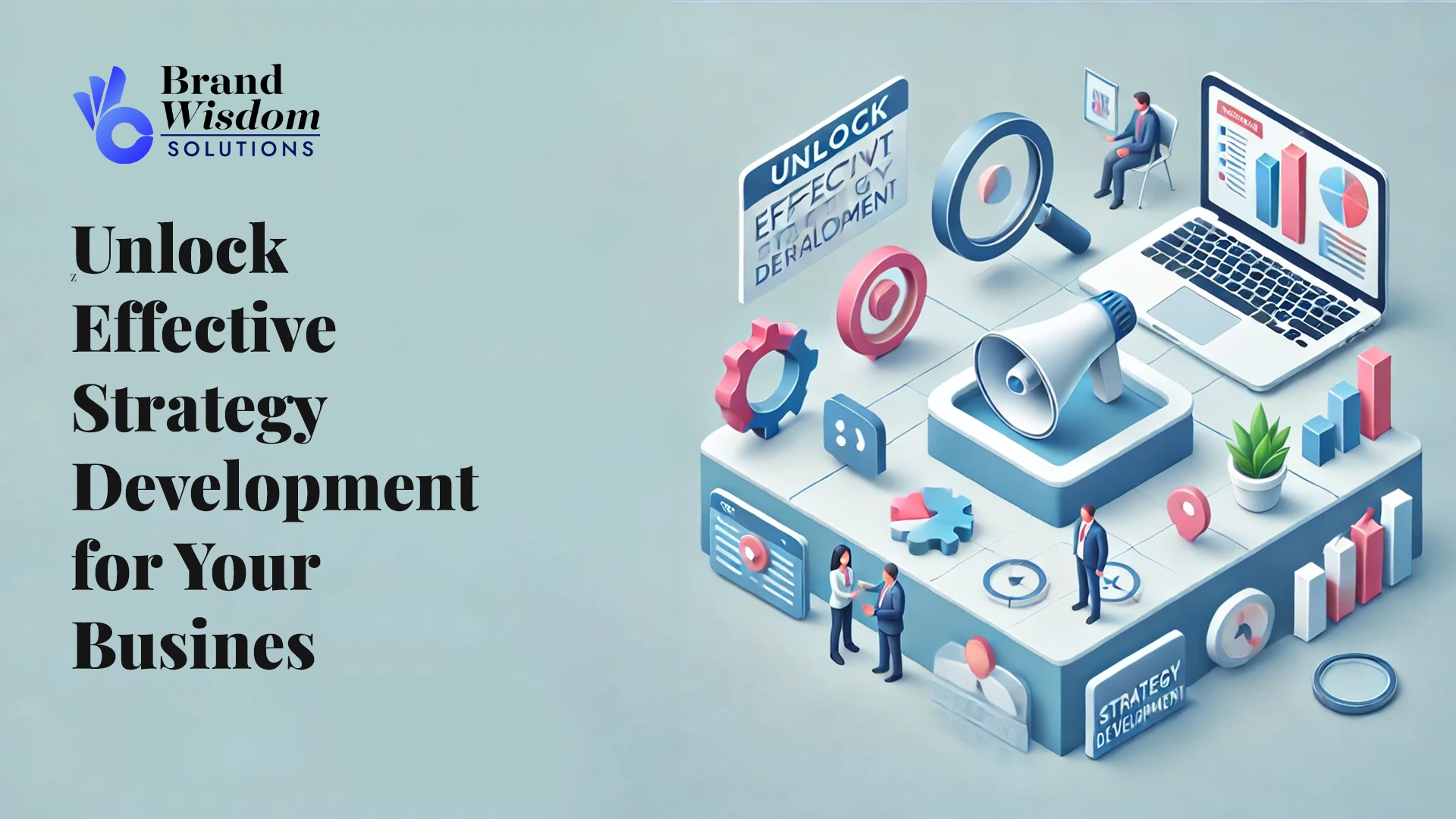In today’s fast-changing business world, strategic management is key for long-term success. Business strategy isn’t just about planning for the future. It’s about building a competitive advantage that helps an organization reach its goals. A strategic plan gives clear objectives and helps deal with tough challenges in today’s competitive landscape. Whether you are starting a new business or have been around for years, good strategy development is important for growing sustainably and hitting your business targets.
Understanding Strategy Development in Business

Strategy development is to design a lucid plan for setting objectives, utilizing resources, and achieving the goals of an organization. Strategy development assists businesses in preparing themselves to respond to market changes and remain faithful to their vision.
Good strategy development enables companies to plan for success and stay on track, while coping with risks and spotting new opportunities. Through enhancing methods and aligning their goals with market demand, companies get clarity. This enables them to operate proactively in a changing world.
Defining Strategy Development
At its core, strategy development is about how businesses manage their plans. They identify goals and create actionable steps to reach them. Strategy formulation helps set priorities, distribute resources, and outline a clear way to achieve organizational goals.
Effective strategic planning is crucial in this process. First, it involves creating the mission and vision statements. These key components shape what the organization wants to achieve and how it will succeed. Once these are in place, businesses can set specific goals using methods like SMART goals. This ensures that objectives are both actionable and measurable.
When done right, strategy development removes confusion. It enables organizations to use their strengths and address their weaknesses. This creates a solid path that connects long-term visions with clear steps to success. It also helps businesses stay strong and adjust to new challenges.
Importance of Strategy Development in Modern Business
In the current hard market, formulating a strategy is crucial for maintaining a competitive edge. It makes companies proactive rather than reactive. Through this, they will better adapt to market changes. Strategically focused companies tend to experience an increase in market share and enhance their operations.
Building a strategy links short-term objectives to long-term aspirations. This causes all stakeholders involved to look over resources, allocate investments for maximum return, and make intelligent decisions towards greater business sustainability. It also helps leaders detect key changes in the external environment that may impact the firm.
Not making a strategy inside is not a strategy. Creating a strategy has to consider what is going to happen outside the company as well. Making fluid but definite plans allows businesses to thrive even under uncertain circumstances. Effective strategy planning makes businesses hardy and poised to convert opportunity into success as well as hardy enough against new threats.
Key Components of Effective Strategy Development

Several key components are important to creating an effective strategy. First, businesses must have clear objectives. They should start by aligning their mission and vision with their goals.
Also, getting stakeholders involved is crucial for good communication and teamwork. By including strategic goals, organizations can track their success through key performance indicators. All these elements work together to turn big ideas into practical actions. They help tackle internal challenges and get ready for changes outside the organization.
Vision and Mission Alignment
Success of an organization begins with an understandable mission statement and vision statement. They facilitate decision-making and goal setting. Shared vision ensures all plans serve long-term goals. A company’s purpose and societal influence is revealed by a mission statement.
A compelling mission statement motivates employees, partners, and stakeholders. It provides the business with a sense of direction on where it wants to go in the marketplace. If the leaders share the vision, then they are able to define long-term objectives that align with their fundamental values.
Ultimately, merging the mission and vision statements ensures everyone is on the same page. Organizational objectives coalesce to construct concrete plans that bridge the grand vision and attainable goals. Combined, they create principles for direction, enabling companies to remain focused throughout the strategic planning process.
Stakeholder Involvement and Its Impact
Stakeholder involvement is key for good strategic planning. When people are included, they are more likely to support the plan. This helps align different departments and levels in the organization. Clear communication with stakeholders reduces misunderstandings in expectations and how things are put into action.
Involving stakeholders brings different viewpoints to the table. This can help find important insights that might be missed, making the strategic plan even stronger. Also, when stakeholders are involved, it shows that the organization cares about social responsibility. This connects their goals with what society expects, which helps build a good reputation and commitment to sustainable practices.
Lastly, active involvement of stakeholders leads to better accountability and teamwork. This makes it easier to put plans into action. When leaders connect stakeholder interests with organizational goals, it helps create a culture where everyone knows the importance of strategic initiatives. This unity can move the organization toward long-term success.
Strategic Goals and Objectives
Defining strategic objectives and goals is central to creating an effective strategy. Employing clear measures such as key performance indicators keeps goals specific and achievable.
Strategic objectives provide guidance. They enable organizations to visualize where they wish to move in the long run. Goals are divided into smaller steps by objectives. It provides a concise path for further movement. An example is when a company plans to increase market share. It may have an objective to introduce new products or acquire additional customers.
Working collaboratively, strategic objectives and objectives establish targets in order to determine success. They also make teams responsible by providing them with concrete goals that align with larger organizational objectives. Having this clear alignment prevents daily operations from going awry and makes it possible to work on large-scale plans, which ultimately means consistent business development in the long run.
Steps to Develop a Robust Business Strategy
Developing a sound business strategy calls for you to pay attention to how things happen within your company and how your company responds to the outside environment. Paying close attention to the existing business environment enables leaders to identify threats and opportunities.
Secondly, leaders must come up with obvious plans that map out the involved resources and schedules. By exerting effort on planning and executing, organizations are able to ensure their plans complement the company and also satisfy outside objectives. The steps enable leaders to ready their teams in the event of complications arising while still maintaining focus on their bigger goals.
Analyzing the Current Business Environment
Knowledge of the business world is critical in developing quality strategies. Factors that are within a company, such as weaknesses and strengths of the company, assist in highlighting where resources are to be deployed. External influences, including industry trends, market changes, and customer behavior, enable companies to discover new challenges and opportunities.
Tools such as SWOT analysis are critical for gaining a complete idea of the business landscape. With a consideration of internal strengths and external threats, companies can gain improved insight into market changes. It enables them to determine how to compete with others. It also provides clarity on innovating or improving operations.
Leaders who continuously monitor the business landscape are in a position to modify their strategies for current and future demands. With a clear picture of their environment and realistic plans, organizations are able to make decisions based on their current and future vision. This enables them to remain adaptable amidst frequent changes.
Identifying Strategic Opportunities and Threats
Recognizing good opportunities can assist businesses to thrive in a difficult market. Companies can adapt to changes in the market and emerging threats by examining what lies beyond their walls.
Market changes result from customer requirements, emerging technology, and company regulations. They present opportunities for strategic planning. When businesses become aware of the trends, they can concentrate on their objectives and determine whether they should innovate or become more productive.
Detection of threats enables companies to prepare for challenges. Conditions such as competitors’ low pricing or rapidly changing regulations require swift action plans in order to continue running the company well. When companies are able to view challenges on the horizon and devise solutions, they acquire a competitive edge. This renders them powerful and enables them to convert external uncertainties into internal strength.
Formulating Strategic Actions
Creating an action plan connects strategy development with execution. Using tools like a strategy map, organizations can see the steps needed for success. Strategic actions are tied to important goals, making sure the implementation is organized.
An implementation plan outlines tasks, who is responsible for them, and when they should be done. This keeps teams accountable. For instance, businesses may want to cut operating costs by improving workflows. This simpler change links the larger money goals to daily actions.
Involving the whole organization helps ensure that important goals are achieved. Updates based on feedback allow for adjustments when needed, while resources and strategies are used effectively. With solid action plans and smooth integration, businesses can reach their stated goals.
Technologies Influencing Strategy Development

New technologies such as data analysis and digital technology are revolutionizing the way that businesses formulate their strategies. Such new technologies enable businesses to make informed decisions with up-to-date data and future trends.
By using resources that enhance planning and resource allocation, businesses optimize their operations. Incorporating these technologies enhances communication, accountability, and goal monitoring, which enables various departments to collaborate more effectively.
Role of Data Analytics in Strategic Decision Making
Data analytics has become an important tool for making smart decisions. By looking at past trends and current data, organizations can find useful insights into market changes and what customers want.
For instance, key performance indicators help businesses see where they need to improve. They can check how well a product is doing or how many customers stay with them. With data analytics, it is easier to make decisions based on real feedback.
Moreover, predictive analytics helps companies foresee future trends using AI-driven algorithms. This helps them change their strategies ahead of time and stay competitive. The important role of data analytics is to support active planning, allowing businesses to make thoughtful decisions everywhere.
Overcoming Common Strategy Development Challenges
Challenges such as putting strategies into action and facing pushback from company culture require active solutions. Good strategies connect planning to doing, while also dealing with issues that come from people resisting change.
By matching important goals with easy tools for implementation, businesses can handle problems effectively in all areas. This helps them stay ready for challenges that could affect how they use resources and meet timelines.
Aligning Strategy with Operational Execution
Strategic implementation ensures high-level plans align with what is actually happening on the ground. Aligning clear objectives and tying them to day-to-day activities ensures that companies attain their schedules.
Accountability frameworks enhance strategy execution processes through the use of which changes are enabled through feedback. For instance, digital dashboards enable the monitoring of how effectively resources are being consumed. They present areas requiring optimization based on real-time data.
Finally, companies that emphasize cultural fit in execution have a good chance of success in the long term. When strategy initiatives align with how people get things done, it creates a smooth path and improved operations for all.
Addressing Resistance to Change within Organizations
Individuals tend to oppose change when there is an introduction of new strategies. This occurs due to a lack of enough clarity, with company objectives sometimes being unclear or inconsistent. Change management assists businesses in handling any resistance that arises during this process.
When organizations allow for open communication in giving feedback, they create flexibility across all departments. This enables teams to better align with business objectives. It speeds up decision-making and enables clearer policies. As employees continue to witness changes, it assists them in adjusting. An emphasis on overall objectives eases resistance and modifying plans so that the organization can be better prepared, flexible, and able to achieve its objectives.
Best Practices for Sustainable Strategy Development

Sustainable strategy formation is all about ensuring that strategic goals align with organizational missions and goal statements. SWOT analysis and balanced scorecards are tools that facilitate sharing of such strategic goals between departments. Strategic agility is also necessary so that companies are able to implement changes quickly when the business environment undergoes changes. Key performance indicators can assist in monitoring progress. Engaging senior leadership and every member of the team ensures a shared culture, which is a critical requirement for efficient resource allocation. These best practices collectively can enhance prospects of long-term success in the competitive environment of today.
Incorporating Flexibility in Strategic Plans
Flexibility in strategic plans is important for dealing with today’s uncertain business environment. By making changes in response to market shifts or competition, companies can protect their strategic objectives. Key components like a dynamic action plan and agile resource allocation help businesses quickly move necessary resources. Keeping team members updated about changing priorities supports a culture of adaptability. In the end, being flexible improves strategic management. This ensures that strategic goals match the organization’s mission statement, promoting sustainable development and competitiveness.
Importance of Continuous Learning and Development
A learning and development culture that is continuous is essential for developing robust strategies in an organization. In an environment where learning and team work go hand in hand with strategic targets, teams are able to adjust quickly to changes in the market and external factors. Improved staff performance results from a future-oriented culture, and the process of strategic management is enhanced. Continuous training and development ensures team members possess the resources and capabilities needed. This assists in reaching organizational objectives and maintains a competitive edge in the contemporary dynamic business environment.
Strategies for Long-Term Growth and Innovation
Seeking ways for long-term growth and innovation involves aligning strategic goals with a sound knowledge of the market. SWOT analysis and the balanced scorecard are employed to enhance strategic management. This will ensure that projects are in line with both organizational goals and build a competitive edge. Flexible resource allocation enables companies to respond to changes in the market. While so doing, motivating a culture of ongoing learning assists team members to discover new solutions. Monitoring progress against key performance indicators on a regular basis will lay a solid foundation for long-term success.
Conclusion
Good strategy development is all about being in a position to adapt to the internal and external forces. In this manner, organizations are able to achieve their objectives sustainably. If companies concentrate on strategic agility as well as continuous learning, they are capable of responding to market changes. They are also able to enhance innovation as well as enhance their competitive edge. In order to successfully apply strategies, there has to be effective communication between various departments. Utilizing strategies such as SWOT analysis and a balanced scorecard assists in following up on progress. Ultimately, a holistic strategy development process results in distinct outcomes and long-term success





